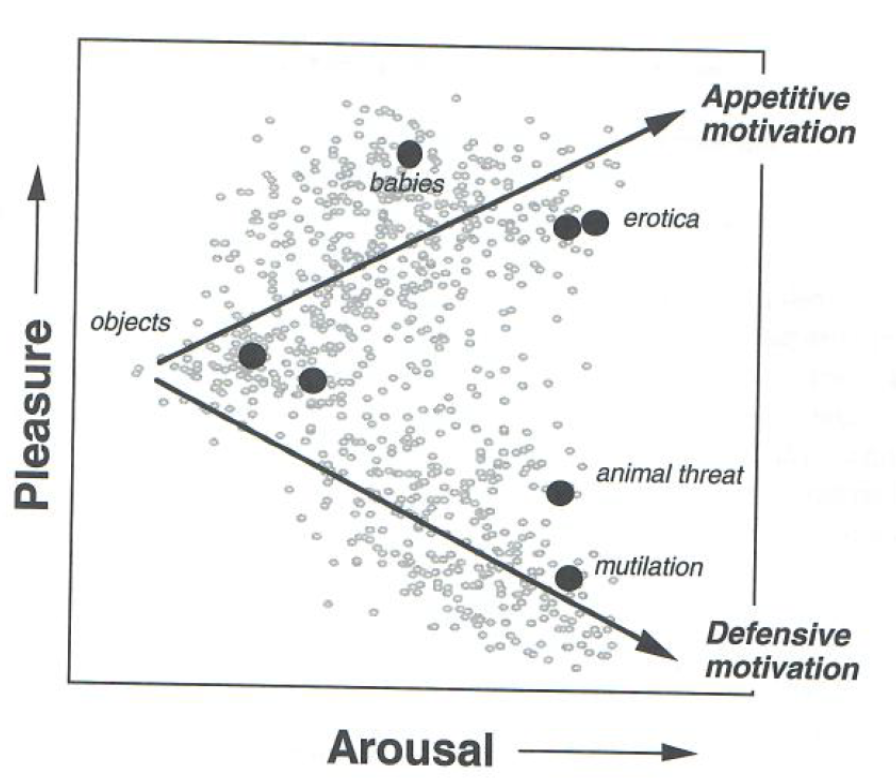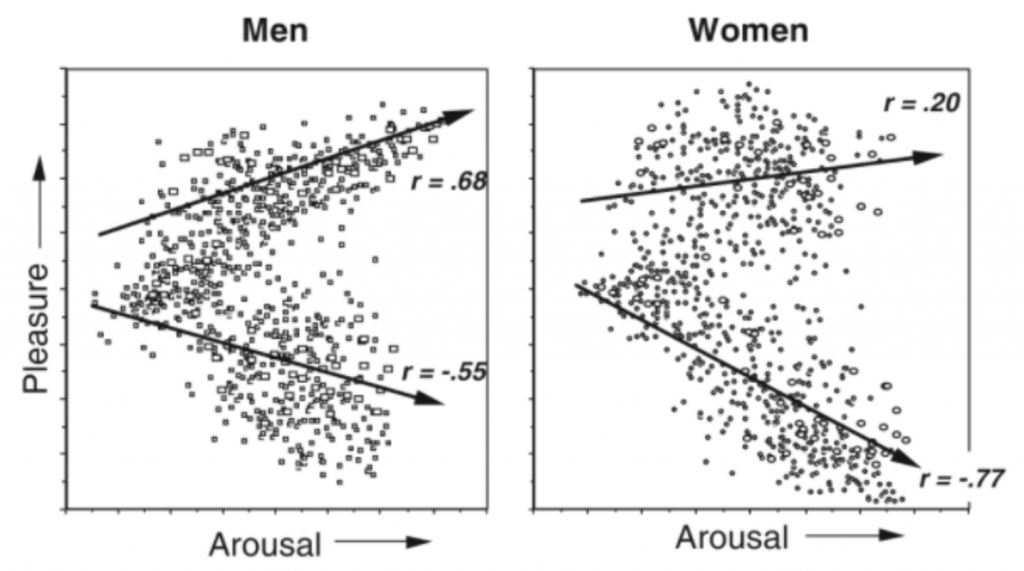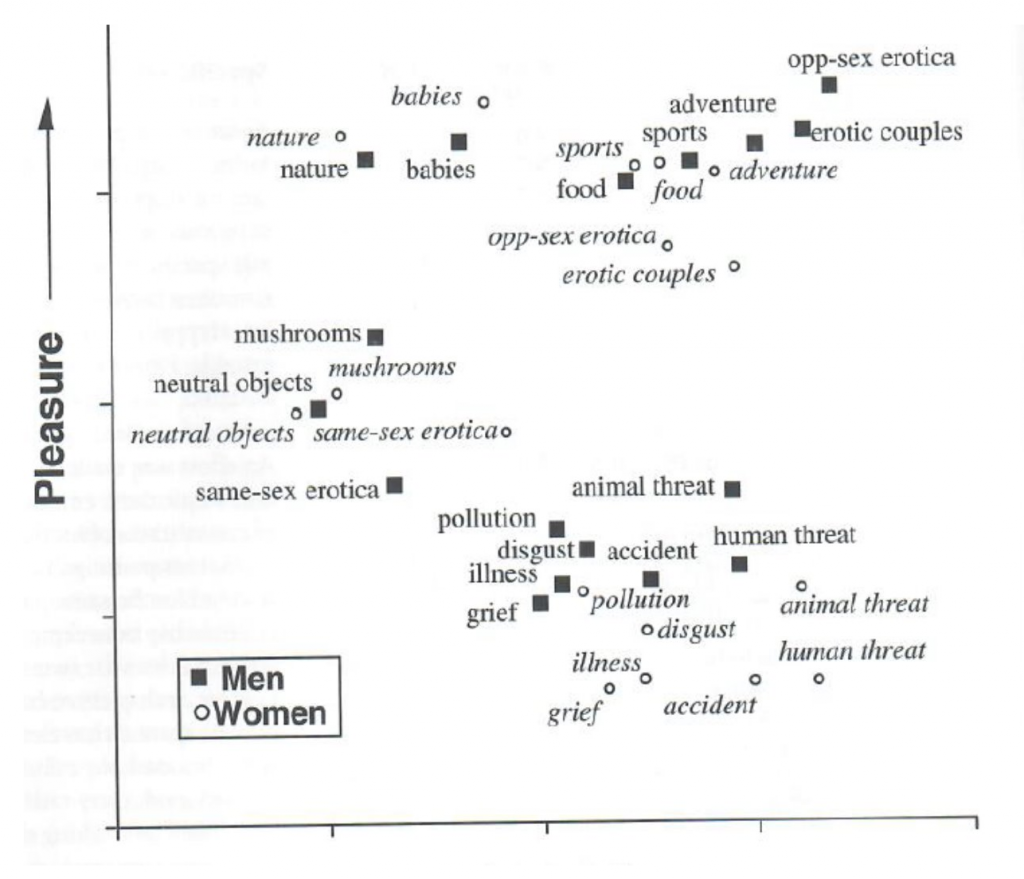Chapter 6: Measuring and Manipulating Emotions
International Affective Picture Systems (IAPS)
The International Affective Picture System (IAPS; pronounced eye-aps; Bradley & Lang, 2007; Lang, Bradley, & Cuthbert, 2008), is a database of photos that may be used to elicit emotions in research. These photos are standardized along the valence and arousal dimensions. Bradley and Lang (2007) , the developers of the IAPS, theorize that these photos measure two evolutionary systems – a defensive system and an appetitive system. Threat activates the defensive system and results in withdrawal, escape, and/or attack behaviors. The appetitive system is activated in safe contexts in which certain behaviors, like reproducing and nurturing children, would increase gene survival. So, the defensive system is adaptive because it protects us from death, whereas the appetitive system is adaptive by creating opportunities for reproduction and raising children into adulthood. According to Bradley and Lang, the valence of an emotion indicates whether the defensive or appetitive system is activated, whereas the arousal dimension determines how intensely the system is activated. How does this relate to IAPS? As displayed in Figure 5, arousal and valence have a boomerang relationship, such that as pictures become more unpleasant or pleasant arousal ratings increase. In other words, Bradley and Lang (2007) state when either system is activated, the arousal ratings are high too. When the motivational systems are not activated, people experience low levels of arousal and neutral valence.
Figure 5
Relationship between Valence and Arousal for IAPS

Long Description
The image is a scatter plot with two labeled axes: the vertical axis represents Pleasure, and the horizontal axis represents Arousal. Data points are grouped into clusters, each labeled with a category: “babies,” “erotica,” “animal threat,” and “mutilation.” These clusters are distributed across the plot based on their emotional characteristics. Gray dots are densely scattered across the graph, with several black dots highlighted to indicate specific data points.
Two diagonal lines divide the plot into three distinct regions:
- The top region is labeled “Appetitive motivation,” indicating stimuli that are both pleasurable and arousing.
- The middle region contains the label “objects,” suggesting neutral or less emotionally charged stimuli.
- The bottom region is labeled “Defensive motivation,” representing stimuli that are unpleasant and arousing, such as threats or harm.
This layout visually maps emotional responses based on their arousal and pleasure levels, often used in psychological or affective science research.
In their research, Bradley and Lang (2007) found that people show individual differences in their ratings of the IAPS photos. 20% of participants exhibited a positive bias and showed a strong, positive correlation between pleasantness and arousal. This means people with a positive bias tend to experience their positive emotions as highly arousing. Conversely, 30% of participants exhibited a negative bias, and showed a strong positive correlation between unpleasantness and arousal. This means people with a negative bias tend to experience their negative emotions as highly arousing. 50% of the participants did not show a bias. As can be seen in the Figure 6 below, men show a positive bias, whereas women show a negative bias (Bradley & Lang, 2007; Bradley et al., 2001). This means women show a stronger correlation between unpleasantness and arousal (r = -.77), whereas men show a stronger correlation between pleasantness and arousal (r = .68). These correlations mean women experience more activation of the defensive system and men experience more activation of the appetitive system. For instance, Figure 7 shows that women rate photos of grief and accidents as higher in arousal than me do. These gender differences parallel gender differences in personality – such that men tend to be higher in Extraversion (the tendency to experience positive emotions), whereas women tend to be higher in Neuroticism (the tendency to experience negative emotions). In fact, evolutionary psychologists suggest that these gender differences in the tendency to experience positive and negative emotions may have helped men and women to solve different adaptive problems. Finally, some findings indicate cultural differences are present in the IAPS. Participants from the USA, Germany, Sweden and Italy, rated IAPS photos (Bradley & Lang, 2007). Compared to American and German participants, Swedish participants rated photos as less arousing, while Italians rated photos are more arousing. Yet, this study is comparing only Western-oriented countries. It would be interesting to compare difference in IAPS ratings between Western and Eastern countries.
Figure 6
Relationship between Valence and Arousal for Men and Women

Long Description
The image features two scatter plots side by side, labeled “Men” on the left and “Women” on the right. Both plots have “Pleasure” on the vertical axis and “Arousal” on the horizontal axis. The plot for men shows two distinct clusters of data represented by small squares, each with an arrow indicating a trend line. The upper cluster has a positive correlation, marked with “r = .68,” while the lower cluster shows a negative correlation, “r = -.55.” The women’s plot, displayed with circles, also indicates two trend lines. The upper line has a positive correlation, “r = .20,” and the lower represents a stronger negative correlation, “r = -.77.”
Figure 7
Valence and Arousal Ratings by Picture Content for Men and Women

Long Description
The image is a scatter plot graph depicting levels of pleasure associated with different stimuli for men and women. The x-axis includes arbitrary notches without labeled values, and the y-axis is labeled “Pleasure” with an upward arrow indicating increasing pleasure. Various labeled points are plotted, using squares to represent men and circles to represent women. Points are distributed across the graph, showing a range of stimuli including “babies,” “nature,” “sports,” “food,” “opposite-sex erotica,” “same-sex erotica,” “erotic couples,” “mushrooms,” “neutral objects,” “adventure,” “animal threat,” “human threat,” “pollution,” “disgust,” “accident,” “illness,” and “grief.” The layout suggests differing levels of pleasure experienced by men and women in response to these stimuli.
It is important to note that the IAPS do not measure discrete emotions. Research shows that participants select many different emotion labels for the same photo. Participants show the highest agreement for photos that elicit disgust – pollution, spoiled food, dirty toilets. A similar database of open access photos can be found at Open Access Affective Standardized Images (OASIS) (Kurdi, Lozano, & Banaji, 2016)

